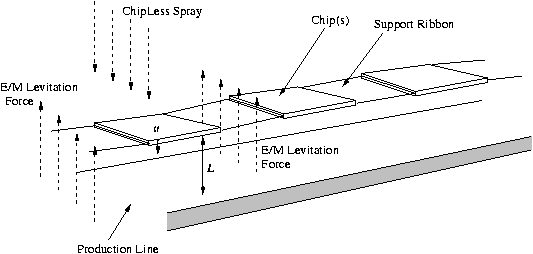
27 March 2000
Rigorous Mathematical Contractors, Inc.
Suite 3, Strawmarket Business Plaza
Lonlinc, SK 04685
Dear Rimac:
Continuing to be a leader in the manufacture of all manner of chemical products, Chemproc, Inc. is proud to be the sole creator of the anti-scratch conduction-enhancing microchip coating known by its development name ``ChipLess.'' As we move into the production of the second generation formulation of this coating, we are experimenting with a new process by which it may be applied.
The process under consideration is shown in figure 1. After
experimenting with electomagnetic levitation, we determined that this
alone was insufficient to keep the chips in their correct orientation,
and we now have them attached by a ribbon, as shown. Because it is
kept under a uniform tension, the ribbon acts to resist movement of
the chips up or down as they move through the sprayer.

Obviously, in order for this to work we must be sure that we know the height at which the chips will be levitated, and it is to analyze this that we are contacting you. We employed an itinerant physicist for some paltry wages to develop a model for the behavior of the chips, but owing to his seedy nature and abrupt disappearance to take up a new career as a professional bookie working on the NCAA basketball tournament we are relying on you to verify his work and complete it.
The physicist's notes say something to the effect of the following: ``the motion of a chip is given, of course, by the brilliant law of Newton (actually a mathematician rather than a physicist---why didn't I study math or become a gambler, anyway?), which requires that the sum of the forces be equal to the mass of the chip times its vertical acceleration. For forces, it is reasonable to suppose a damping term linear in the chip's velocity (with coefficient c), a Hooke's law spring force resulting from the ribbon (with spring constant k), gravity and the electromagnetic force. As most anyone knows, the last is proportional to one over the square of the distance between the chip and the production line (with constant of proportionality E).
``Letting u be the displacement of the chip from the desired height
L, it is convenient to scale the equation to reduce the number of
parameters. This can be done by taking u = h w and t = T s (so
that the equation is rewritten as an equation for w(s)).
Choosing h and T suitably, the governing equation may be rewritten
as
``Of course, this changes slightly if the ribbon is better modeled with a soft-spring, in which case the spring term might be better represented as K(w(s) - (1/2) w3(s)).''
Based on this limited information (it's just as well we didn't pay him much, because he doesn't seem to have left us much for it!) we need you first to verify this work and equation, and second to determine what it tells about the height at which the chip may be found---and how this depends on the parameter K that is indicative of the tension in the ribbon. We suspect that his ramblings about the ``soft-spring'' is of more theoretical than practical interest, but would also be interested in knowing if this is a ``slight change'' as he indicated, or a more significant one. After all, a slight change to a gambler could be almost anything.
We look forward to receiving your final report on or before the 10th of April. To assure your success in your work, we have taken a contract out on---or rather, contracted with---the estimable if inscrutable Dr. P. Gavin LaRose to answer any questions you may have in the course of your investigation. Please note that you must meet with him by the end of this week to verify your initial progress on the project.
Sincerely,
E. Idu Pont
President, Chemproc, Inc.
eip:glr